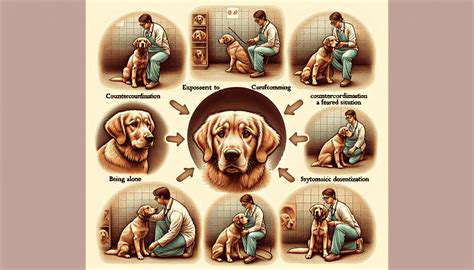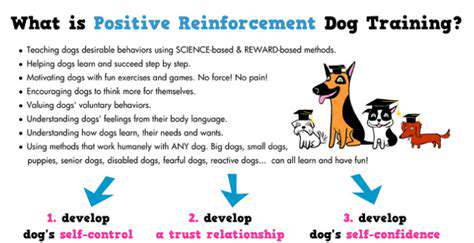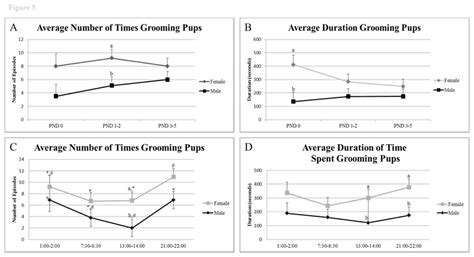Pet Stress and Anxiety: Signs and Solutions
Recognizing the Signs of Stress in Your Furry Friend
Physical Signs of Stress
Observing your pet's physical cues is crucial in recognizing stress. Changes in posture, such as hunching, a tucked tail, or flattened ears, can indicate discomfort or anxiety. Notice if your pet exhibits excessive panting, tremors, or changes in their usual grooming habits. These physical manifestations often accompany underlying stress and can be subtle, requiring careful observation over time.
Another physical sign to look for is changes in appetite. If your pet suddenly stops eating or has a drastic decrease in their food intake, it could be a significant indicator of stress. Similarly, excessive eating, or a sudden increase in eating, can also be a sign of stress, as the pet might be using food to cope with anxiety or discomfort. Pay close attention to these changes in eating patterns as they can be valuable indicators of stress.
Behavioral Changes as Indicators
Beyond physical cues, behavioral changes are often noticeable and can help you identify stress in your furry friend. A dog that is usually outgoing might become withdrawn and avoid social interaction. A cat that typically enjoys playtime might become lethargic and hide. A change in their usual routines, like avoiding their favorite spots or exhibiting destructive behaviors, can also signal distress.
Changes in vocalization patterns, such as excessive barking or meowing, or the sudden onset of whimpering or howling, can also be signs of stress. Consider if the behavior is out of character for your pet. If so, it might be worth investigating the possible causes of stress and seeking appropriate solutions.
Changes in elimination habits like frequent urination, or defecation in inappropriate places can also be a sign of stress. Sudden house soiling or changes in bathroom habits can be a major indicator that something is not right. Pay close attention to these changes as they can be linked to stress and anxiety.
Anxious pets may also display compulsive behaviors, such as excessive licking, chewing, or digging. These repetitive actions might be a way for your pet to cope with underlying stress or anxiety. If you notice any of these behaviors, it's important to address the issue to prevent further escalation.
Environmental and Lifestyle Factors
Stress in pets isn't always directly observable. Changes in their environment or lifestyle can contribute to stress. A new pet in the household, a move to a new home, or loud noises can all cause anxiety. Familiarize yourself with your pet's normal routine and identify any recent changes that might be causing stress.
Consider if there are any environmental factors that might be contributing to your pet's stress. A noisy environment, a lack of stimulation, or changes in their living space can all affect their well-being. Adjustments to their environment may help ease anxiety and stress.
Environmental Factors and Their Impact on Pet Well-being

Environmental Factors Affecting Plant Growth
Environmental factors play a crucial role in shaping the growth and development of plants. These factors, encompassing a wide range of influences, directly impact various physiological processes, from photosynthesis and nutrient uptake to reproduction and defense mechanisms. Understanding these interactions is essential for optimizing agricultural practices and promoting sustainable plant growth.
Temperature Fluctuations and Plant Responses
Temperature significantly influences plant growth and development. Optimal temperatures vary greatly among plant species, and deviations from these ranges can lead to impaired growth, reduced yields, and even plant death. For example, prolonged exposure to freezing temperatures can damage plant tissues, while extreme heat can lead to stress and reduced photosynthetic activity.
Different plant species have evolved various mechanisms to cope with temperature fluctuations. Some plants have adaptations to tolerate freezing temperatures, while others exhibit drought tolerance mechanisms to withstand high temperatures and water stress.
Light Intensity and Photoperiod
Light intensity and photoperiod are critical factors in plant growth and development. Sufficient light is necessary for photosynthesis, the process by which plants convert light energy into chemical energy. Variations in light intensity and duration can affect the rate of photosynthesis, influencing plant growth and development.
Photoperiod, the duration of daylight, plays a significant role in regulating plant flowering and other developmental stages. Many plants have evolved specific responses to changes in photoperiod, allowing them to flower at the appropriate time of year.
Water Availability and Plant Growth
Water availability is a fundamental environmental factor affecting plant growth. Water is essential for various physiological processes, including nutrient transport, photosynthesis, and cell expansion. Adequate water supply is crucial for maintaining turgor pressure, which is essential for the structural integrity of plant tissues.
Drought conditions can severely limit plant growth and yield. Plants exhibit various adaptations to conserve water, such as reduced leaf size, drought-resistant root systems, and mechanisms to reduce transpiration.
Nutrient Availability and Uptake
Nutrient availability in the soil is another crucial environmental factor affecting plant growth. Essential nutrients, such as nitrogen, phosphorus, and potassium, are vital for various physiological processes, including chlorophyll synthesis, protein production, and energy storage. Nutrient deficiencies can lead to stunted growth, reduced yields, and other negative impacts on plant health.
Soil pH and Mineral Composition
Soil pH and mineral composition directly affect nutrient availability and uptake by plants. Optimal pH ranges vary among different plant species. Soil acidity or alkalinity can influence the solubility and availability of essential nutrients, affecting plant growth and development.
Variations in soil mineral composition can significantly impact plant nutrition. Plants require specific mineral elements for optimal growth, and imbalances in these elements can lead to nutrient deficiencies or toxicities.
Atmospheric Gases and Air Pollution
Atmospheric gases, particularly carbon dioxide (CO2) and other pollutants, influence plant growth and development. Elevated CO2 levels can stimulate photosynthesis, potentially increasing plant growth. However, air pollutants can negatively impact plant health by damaging leaves, affecting photosynthesis, and reducing growth.

Behavior Modification Techniques for Calming Anxious Pets

Classical Conditioning
Classical conditioning, a cornerstone of behavior modification, involves associating a neutral stimulus with a stimulus that naturally elicits a response. This association eventually causes the neutral stimulus to produce a similar response. A classic example is Pavlov's dogs, where the sound of a bell (initially neutral) was paired with food (naturally eliciting salivation). Over time, the dogs learned to salivate at the sound of the bell alone. This technique is useful for developing positive associations with certain stimuli, such as using pleasant smells or images to create a more positive response to a particular activity or environment. It is also important to note that negative associations can be formed through this process, which can be problematic and require careful consideration in therapeutic applications.
Through repeated pairings, a neutral stimulus becomes a conditioned stimulus, eliciting a conditioned response. This process can be employed in various settings, from treating phobias to improving workplace productivity. By carefully controlling the stimuli and their pairings, practitioners can modify behaviors by influencing the associations individuals form.
Operant Conditioning
Operant conditioning focuses on the consequences of behavior. This approach emphasizes that behaviors followed by desirable consequences are more likely to be repeated, while behaviors followed by undesirable consequences are less likely to be repeated. The use of reinforcement and punishment is central to this method. Reinforcement can be positive (adding a desirable stimulus) or negative (removing an aversive stimulus). Punishment, conversely, involves either presenting an unpleasant stimulus or removing a desirable one. Understanding the principles of operant conditioning is crucial in shaping behaviors in various contexts.
For instance, if a child completes their homework promptly, they might be rewarded with extra playtime. This positive reinforcement strengthens the behavior of completing homework. Conversely, if a child consistently disrupts class, they might be temporarily removed from the activity. This negative consequence aims to decrease disruptive behavior. By carefully choosing the consequences, educators and parents can modify undesirable behaviors and encourage positive ones. Careful consideration must be given to the potential unintended consequences of using punishment, as it can sometimes create anxiety or resentment.
Cognitive Behavioral Therapy (CBT)
Cognitive behavioral therapy (CBT) is a powerful approach that combines cognitive and behavioral techniques to address a wide range of psychological issues. CBT focuses on the interplay between thoughts, feelings, and behaviors, recognizing that negative thoughts and beliefs can influence actions and emotions. This approach aims to identify and challenge negative thought patterns and replace them with more realistic and helpful ones. This process often involves identifying triggers and developing coping mechanisms to manage challenging situations.
CBT techniques, such as cognitive restructuring and exposure therapy, are valuable tools for modifying behaviors. Cognitive restructuring helps individuals identify and modify negative thought patterns, which can then lead to changes in behavior. Exposure therapy, on the other hand, gradually exposes individuals to feared stimuli, reducing anxiety and avoidance behaviors. These strategies can be highly effective in treating conditions like anxiety disorders and depression.
Social Learning Theory
Social learning theory emphasizes the importance of observation and modeling in learning new behaviors. Individuals learn not only through direct experience but also by observing others and the consequences of their actions. This theory highlights the significant role of social influences in shaping behavior. For example, children often learn behaviors by observing and imitating parents, peers, and role models. This process can be seen in both positive and negative behaviors.
Observational learning plays a crucial role in acquiring social skills and adapting to different situations. By observing and imitating others, individuals can learn new behaviors and modify existing ones. This approach is applicable in various settings, from educational environments to therapeutic contexts. Understanding the mechanisms of social learning can help us develop strategies to promote positive social behaviors and attitudes.
Seeking Professional Veterinary Help for Underlying Issues
Identifying Potential Stressors
Pets, much like humans, experience stress and anxiety, often stemming from identifiable triggers. Understanding these triggers is the first step towards providing effective relief. Common stressors include changes in routine, loud noises, new environments, or the introduction of unfamiliar pets or people. Recognizing these situations and their impact on your pet's well-being is crucial for providing proactive care.
Observing your pet's behavior closely is key. Changes in appetite, sleep patterns, elimination habits, or vocalizations can all indicate underlying stress. Pay attention to subtle cues, as these can provide valuable insight into what's causing your pet's distress.
Recognizing Behavioral Symptoms
Behavioral changes are often the first and most apparent signs of stress in pets. These can manifest in various ways, ranging from excessive barking or whining to destructive chewing or self-harm. Understanding these behaviors is crucial to determining the cause and implementing effective solutions. For example, excessive panting, pacing, or trembling can all point to anxiety.
Assessing the Severity of the Issue
Determining the severity of your pet's stress or anxiety is vital for tailoring the appropriate course of action. Mild anxiety might be managed with simple environmental adjustments. However, more severe cases may require professional veterinary intervention, such as medication or specialized therapies.
Consider the duration and intensity of the symptoms. Are these issues short-term or long-lasting? Do the behaviors interfere with your pet's daily life and overall well-being? These factors can help you assess the urgency and severity of the situation.
Exploring Environmental Factors
Environmental factors play a significant role in a pet's stress response. A cramped or noisy environment can contribute to anxiety. Changes in their surroundings, such as moving to a new home or a new room, can be stressful. Consider the layout of your home and how it might impact your pet's safety and comfort. A safe space, free from potential stressors, can be crucial for reducing anxiety.
Investigating Underlying Medical Conditions
Sometimes, behavioral issues stemming from stress or anxiety can stem from underlying medical conditions. A thorough veterinary examination can rule out any physical ailments that might be contributing to your pet's distress. Conditions such as pain, allergies, or hormonal imbalances can manifest as behavioral changes, and professional veterinary care can help identify and address these.
Seeking Professional Veterinary Guidance
If you suspect your pet's stress or anxiety is impacting their quality of life, consulting a veterinarian is essential. A veterinarian can conduct a comprehensive evaluation, assess your pet's specific needs, and recommend appropriate treatment options. This could involve behavioral modification techniques, medication, or a combination of approaches tailored to your pet's individual circumstances. They can provide a personalized plan to help manage and alleviate your pet's stress.
Managing Stressful Situations
Once the underlying cause of your pet's stress is identified, the next step is to implement appropriate management techniques. This might involve creating a safe space for your pet, adjusting their environment to minimize triggers, or using calming aids like pheromone diffusers. Consistent and positive reinforcement during interactions with your pet will also be key to managing these situations effectively. Professional guidance from a veterinary behaviorist can be invaluable in developing a tailored strategy.
Read more about Pet Stress and Anxiety: Signs and Solutions
Hot Recommendations
- Best Pet Bowls: Stainless Steel and Ceramic
- Pet Hydration: Why It's Crucial
- Stop Counter Surfing: Training Your Dog to Stay Off
- Pet Hypothyroidism: Symptoms and Management
- Signs of Pet Liver Disease: What to Watch For
- Pet Emergency Kits: What to Pack
- Dangers of Xylitol: Toxic to Dogs
- Dealing with Pet Diarrhea: When to See a Vet
- Preparing Pets for Travel: Tips for a Smooth Trip
- Pet Depression: Recognizing the Signs











